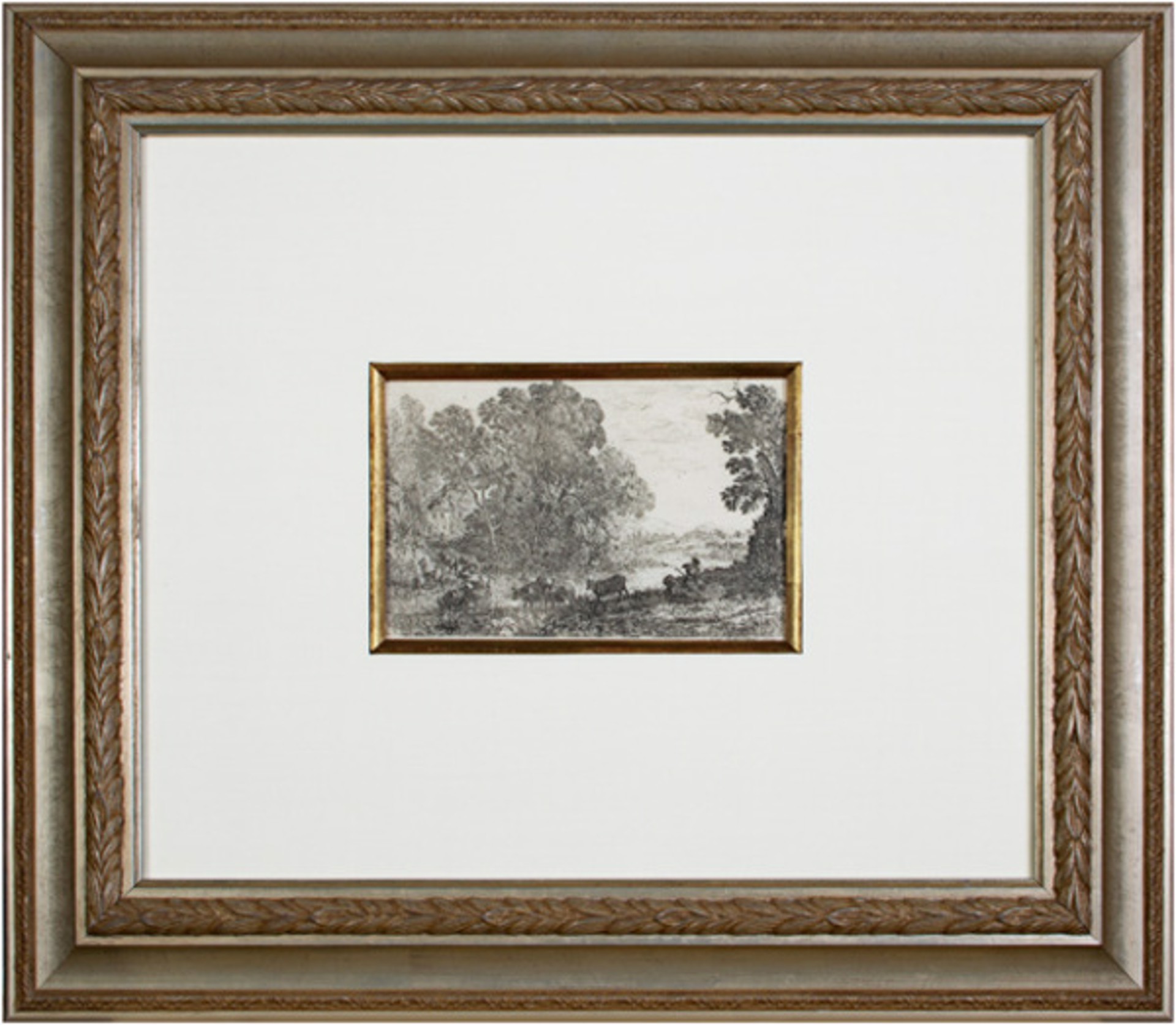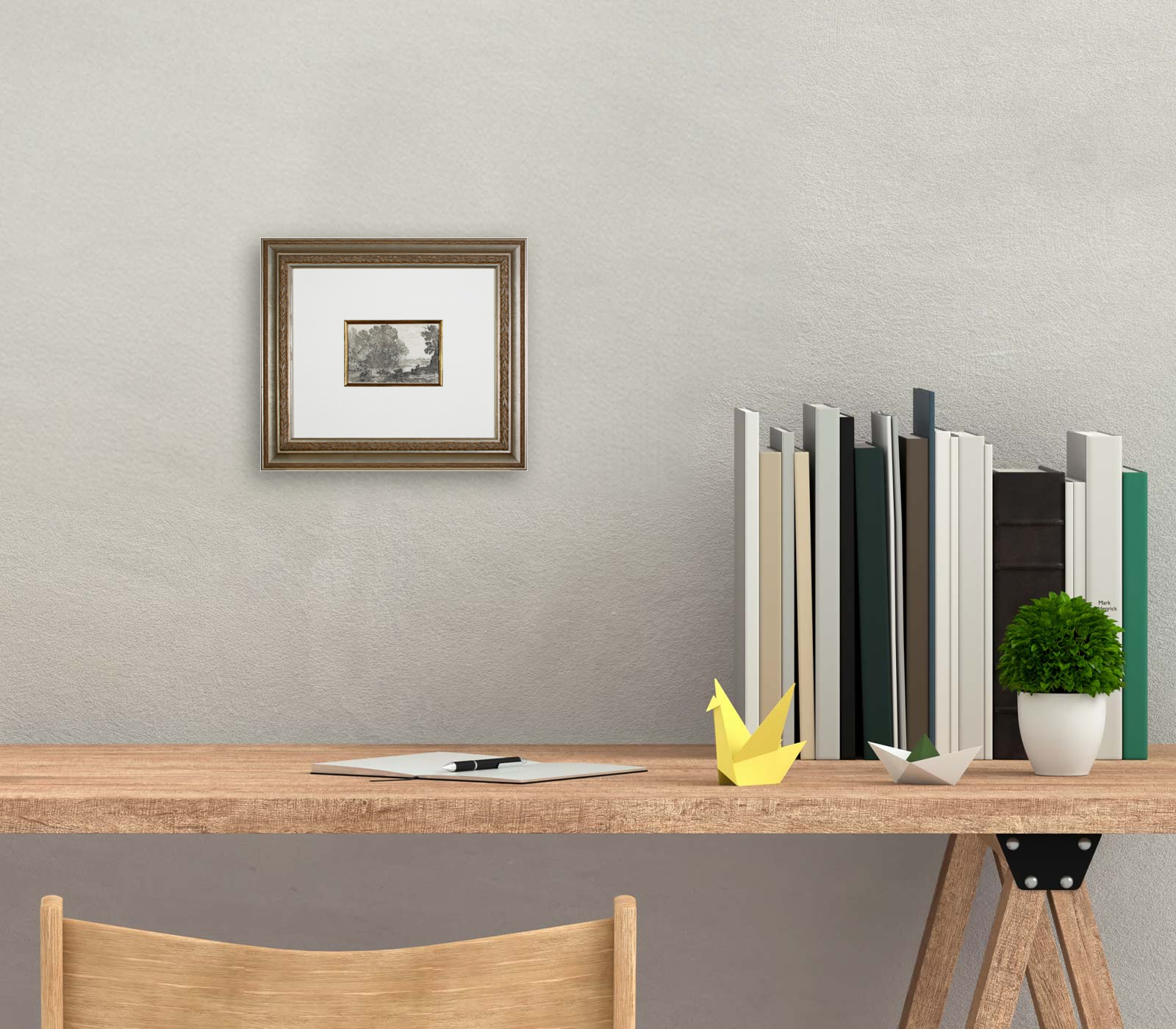Le Bouvier (the cowherd)
Claude Gellée (Claude Lorrain)
Le Bouvier (the cowherd)
Artist:
Claude Gellée (Claude Lorrain)
Medium: Prints
Price:
$4,500.00
Gallery:
David Barnett Gallery
Add to Favorites
Details
Creation Date: 1636
Materials: Etching
Dimensions: 5" x 8"
Condition: Excellent condition.
Finish: Framed
About the Item
This etching is also in the collections of the Met and the Louvre. It was published by Mannocci #18.
"Le Bouvier" is an original etching by Claude Gellée, known as Claude Lorrain or simply Claude. The work depicts a cowherd with his cows in the foreground, set against an idyllic landscape with ruins in the left background and in the right distance. The work is an example of Claude’s staging of nature and representing an idealized pastoral scene.
Claude Lorrain, a French contemporary of Rembrandt working in Rome in the seventeenth century, was a great landscape artist. Like Rembrandt, most of Claude’s paintings are history paintings with figures which represent a biblical or mythological scene. His drawings and etchings, like Rembrandt’s, focus on his construction of the natural world, as in Le Bouvier. Joachim van Sandrart, a German artist and one of Claude’s biographers, described the artist’s working methods for capturing the essence of nature. He wrote that Claude “...studied his art with great seriousness and application; he tried by every means to penetrate nature, lying in the fields before the break of day and until night in order to learn to represent very exactly the red morning sky, sunrise and sunset and the evening hours. When he had well contemplated one or the other in the fields, he immediately prepared his colors accordingly, returned home and applied them to the work he had in mind with much greater naturalness than anyone had ever done.”
Claude and his contemporary, Nicholas Poussin, were lauded for their classical landscapes that stressed balance and harmony as opposed to verisimilitude to a particular locale. The eighteenth-century poet and philosopher, Goethe, stated: “The pictures are True, yet have no trace of actuality. Claude Lorrain knew the real world by heart, down to the minutest details, but he used it only as a means of expression the world of his beautiful soul. And this, precisely, is true ideality: to avail oneself of realistic means to reveal the True in such a way that it creates an illusion of being the Real.” While Le Bouvier depicts a pastoral rather than a classical subject, the formal elements of the scene are laid out with the balance and harmony of a history picture.
Landscape had a low status in the hierarchy of genres during Claude’s time. Despite his mastery of landscape and his legacy as one of the most accomplished landscape painters in Western art history, Claude was known during his time as a history painter, representing mythological and religious subjects. In seventeenth-century Europe, landscape, like still life and genre painting, was believed to be a genre that lacked moral seriousness. In the matter of the significance of landscape painting, Claude was prescient. Although he did not depict the uninhabited panoramas esteemed in later centuries and his works featured pastoral worlds populated by classical ruins or seascapes, Claude was, as the nineteenth-century artist John Constable said “the most perfect landscape painter the world ever saw” and declared that in Claude’s landscape, “all is lovely—all amiable—all is amenity and repose; the calm sunshine of the heart.” To satisfy his patrons, his pictures included gods, heroes, and saints, even though his sketchbooks contain many drawings of the natural world.
Artwork Size: 5" x 7 1/2"
Frame Size: 19 3/8" x 21 7/8"
"Le Bouvier" is an original etching by Claude Gellée, known as Claude Lorrain or simply Claude. The work depicts a cowherd with his cows in the foreground, set against an idyllic landscape with ruins in the left background and in the right distance. The work is an example of Claude’s staging of nature and representing an idealized pastoral scene.
Claude Lorrain, a French contemporary of Rembrandt working in Rome in the seventeenth century, was a great landscape artist. Like Rembrandt, most of Claude’s paintings are history paintings with figures which represent a biblical or mythological scene. His drawings and etchings, like Rembrandt’s, focus on his construction of the natural world, as in Le Bouvier. Joachim van Sandrart, a German artist and one of Claude’s biographers, described the artist’s working methods for capturing the essence of nature. He wrote that Claude “...studied his art with great seriousness and application; he tried by every means to penetrate nature, lying in the fields before the break of day and until night in order to learn to represent very exactly the red morning sky, sunrise and sunset and the evening hours. When he had well contemplated one or the other in the fields, he immediately prepared his colors accordingly, returned home and applied them to the work he had in mind with much greater naturalness than anyone had ever done.”
Claude and his contemporary, Nicholas Poussin, were lauded for their classical landscapes that stressed balance and harmony as opposed to verisimilitude to a particular locale. The eighteenth-century poet and philosopher, Goethe, stated: “The pictures are True, yet have no trace of actuality. Claude Lorrain knew the real world by heart, down to the minutest details, but he used it only as a means of expression the world of his beautiful soul. And this, precisely, is true ideality: to avail oneself of realistic means to reveal the True in such a way that it creates an illusion of being the Real.” While Le Bouvier depicts a pastoral rather than a classical subject, the formal elements of the scene are laid out with the balance and harmony of a history picture.
Landscape had a low status in the hierarchy of genres during Claude’s time. Despite his mastery of landscape and his legacy as one of the most accomplished landscape painters in Western art history, Claude was known during his time as a history painter, representing mythological and religious subjects. In seventeenth-century Europe, landscape, like still life and genre painting, was believed to be a genre that lacked moral seriousness. In the matter of the significance of landscape painting, Claude was prescient. Although he did not depict the uninhabited panoramas esteemed in later centuries and his works featured pastoral worlds populated by classical ruins or seascapes, Claude was, as the nineteenth-century artist John Constable said “the most perfect landscape painter the world ever saw” and declared that in Claude’s landscape, “all is lovely—all amiable—all is amenity and repose; the calm sunshine of the heart.” To satisfy his patrons, his pictures included gods, heroes, and saints, even though his sketchbooks contain many drawings of the natural world.
Artwork Size: 5" x 7 1/2"
Frame Size: 19 3/8" x 21 7/8"
About the Artist
Claude Gellée (Claude Lorrain)
Claude Lorrain, born Claude Gellée around 1604 in Chamagne, Lorraine, France, emerged from poverty to become a renowned Baroque landscape painter. Orphaned at twelve, he lived with his brother in Freiburg, then traveled to Rome and Naples, apprenticing under artists Goffredo Wals and Augustin Tassi. He experienced numerous adversities during his early travels across Italy, France, and Germany. Lorrain returned to Rome in 1627, gaining fame and papal patronage by 1637. Unlike contemporary Nicolas Poussin, Lorrain's landscapes were the main focus of his paintings, often with figures painted by others. To combat forgeries, he created the Liber Veritatis, a record of his works. Dying in Rome on November 23, 1682, he left a legacy as a pioneering landscape artist, praised by John Constable as "the most perfect landscape painter the world ever saw." His pastoral scenes, blending nature with architecture and human activity, marked a significant shift from the traditional religious and mythological subjects of the time.
About the Gallery
David Barnett Gallery
The David Barnett Gallery is Wisconsin's premier gallery with the broadest range of art available in the region, including works of art that represent more than 600 artists. The gallery specializes in European and American masters, regional and nationally recognized artists and emerging artists. This gallery also offers museum quality custom framing, restoration, conservation, appraisals, printing, transportation and delivery.
Similar Artworks
Similar Artists
More from this Seller







 Facebook
Facebook
 X
X
 Email
Email























